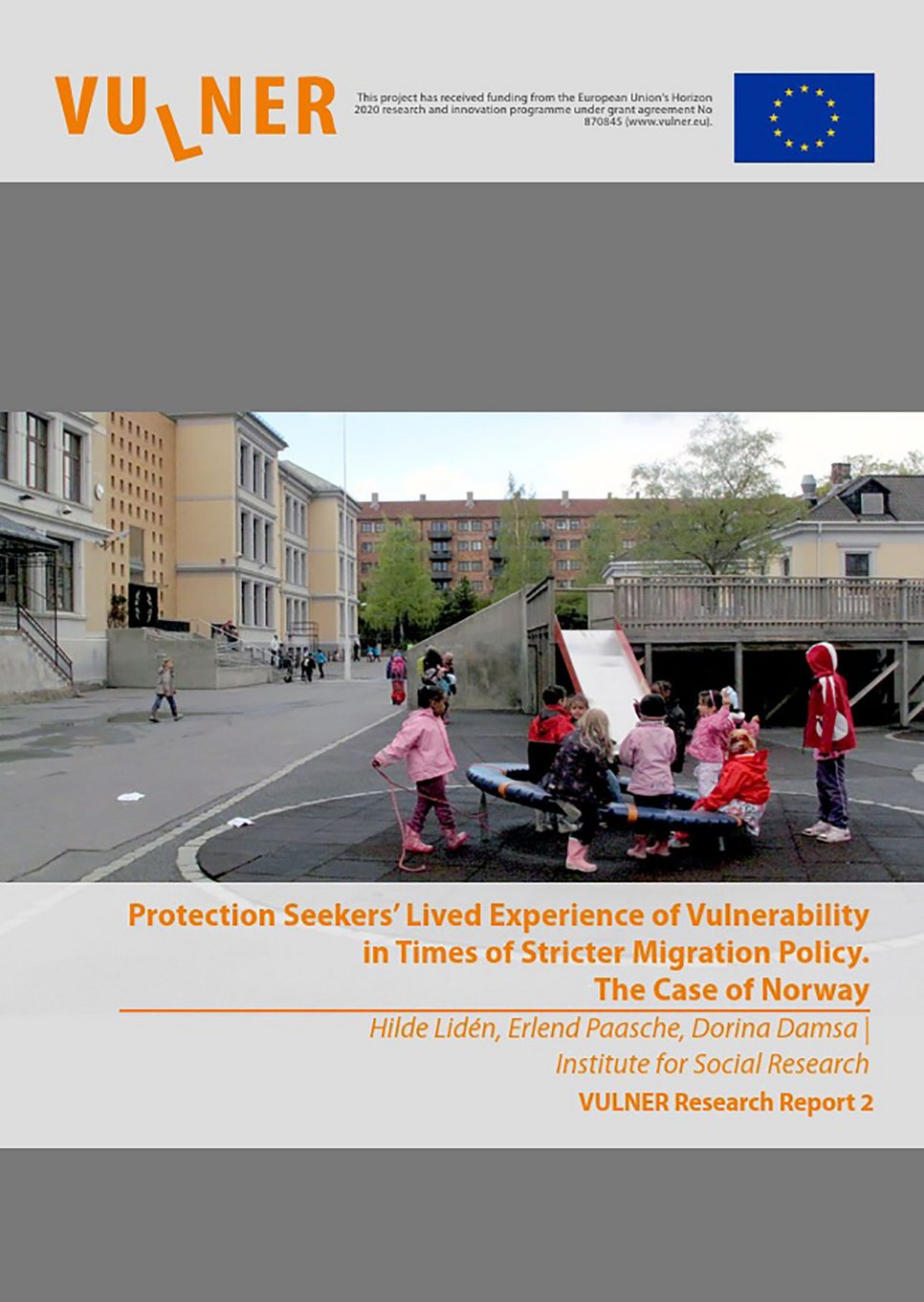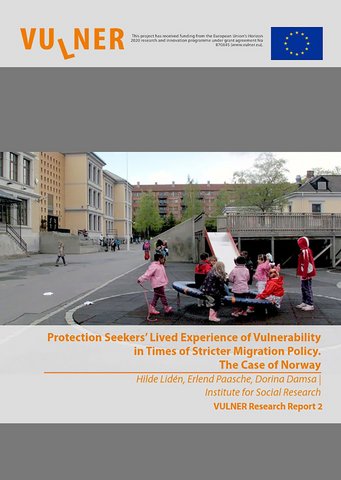Protection Seekers’ Lived Experience of Vulnerability in Times of Stricter Migration Policy. The Case of Norway
Research report on the experiences of migrants seeking protection in Norway - by Hilde Lidén, Erlend Paasche and Dorina Damsa

In this report, we explore how asylum seekers and refugees resettled from third countries reflect on vulnerabilities in their lives prior to arrival and when they stay in Norway. We discuss the extent to which Norwegian protection procedures, reception conditions and welfare service identify vulnerabilities and capture what the protection seekers describe as their needs and concerns.
Most asylum seekers arriving in Norway come from countries with ongoing civil wars. Norway’s asylum legislation, through its human rights approach, consistently alludes to vulnerability. The implementation of international human rights law in Norwegian domestic legislation obliges the state to protect people in vulnerable situations. Despite this, no specific procedure is in place to identify ‘vulnerable’ individuals. As discussed in our first VULNER report, the attention paid to protection seekers’ vulnerabilities in terms of legislation and administrative practice is fragmented, implicit and contradictory (Lidén et al., 2021). Shifts towards more restrictive asylum and immigration policies since 2015 have produced new situational vulnerabilities by making refugee status and residence permits more temporary, making it easier to return migrants to conflict-affected countries and creating barriers to inclusion in Norway for those who cannot return.
Three chapters present the main findings. One outlines the main sources of vulnerabilities that protection seekers bring from their origin country and while they are on the move, another deals with protection seekers’ lived experience of vulnerability in Norway, and the third discusses the implications of an increasingly restrictive migration policy for protection seekers’ everyday lives and futures. The research is based on qualitative methods. The Norwegian team conducted fieldwork between May 2021 and February 2022 in three main arenas: reception centres, the institutional settings of (re)settlement in a larger city and adjusted institutions for the survivors of human trafficking (THB). Altogether, the study includes four categories of protection seekers: those living in reception centres, resettled refugees, unaccompanied minors (UAMs) and protection seekers with an irregular status settled in a larger city and THB survivors. We also included informants representing the two reception centres, the centre responsible for (re)settlement, a health centre for refugees and non-governmental organizations (NGOs) that are important in protection seekers’ everyday lives. We conducted 34 interviews with 35 protection seekers and 23 interviews with 31 people working in the institutional context of the everyday lives of protection seekers.
When describing their lived experiences, our informants tell us about various forms of fear, violence, destroyed cities and harmful events causing the departure from home. They stress relational costs, the unexpected feeling of being on their own or leaving behind someone in a precarious situation. The cases of lived experience from their former countries and while on the move display the complexities shaping their precarious situation. Their individual situations and concerns go beyond personal characteristics of vulnerability and instead display how vulnerability factors on different levels intersect with one another in specific ways. Vulnerability is seldom the term or concept they use to describe their situation. Instead,
they identify specific barriers, worries and concerns, reducing their ability to act and move forward with their lives. The personal narratives include how their individual positions in the family and local factors such as local conflicts, discrimination and harassments intertwine with societal factors such as political, cultural and social conflicts. Broader structural factors such as persecution by a repressive state or civic authorities, legislation and immigration and border control are all clearly present in their stories.
We divide the main findings into three parts:
- identifying vulnerability in asylum procedures,
- lived experience of reception conditions and
- vulnerability shaped by the asylum system and an increasingly restrictive migration policy.
In the arrival procedure, there are no explicit measures assessing vulnerabilities; however, the responsibility for identifying and categorizing people with extra needs and dedicated rights is an integral part of the ordinary registration and asylum procedure. Legal modification for categories such as children, gender-related abuse and harm, LGBTQIA+ minorities and THB victims THB are addressed when referring to human rights. The need for improved measures of vulnerability assessment relates to specialists and measures, to identify more covered harm, trauma and persecution that is difficult to disclose, ensuring access to competent health specialists following up on trauma and torture, and the routine of communicating and documenting harm between actors.
In times of increasing arrivals, the arrival procedures are delayed or adjusted to more limited or speedy routines and thus do not work optimally. One key finding is the need for sufficient routines even in the periods with numerous arrivals. We have documented the personal costs of procedural ruptures that occur when the adjusted procedures do not work, such as age assessments or reception conditions for UAMs. We also see the need for improvements in the adjusted procedures, such as including second opinions in the age assessment or improved reception standards for the oldest minors.
We also identify gaps in the measures for identifying and supporting THB victims and the need for a national referral mechanism to ensure sufficient support in all cases and a broad approach on how vulnerability factors interact in trafficking cases.
To guarantee procedural justice, Norway has accommodated hearing procedures related to age, such as a child hearing procedure and ensuring a representative present for UAMs, to gender (the choice of interpreter gender) and certain guidelines about interviewing and following up those with trauma, LGBTQIA+ minorities, and victims of THB. Despite these adjusted asylum procedures for those with extra needs, vulnerabilities remain under the radar. We have identified several barriers in the hearing procedure from the informants’ point of view: the lack of sufficient information about the hearing procedure to grasp the legal rationale in the assessment; the need for more legal advice early in the procedure; and the need for interpreters with improved skills when disclosing private, demanding experiences. They stress the implications of slow administrative procedures and insufficient information about the process, which adds to their feeling of lack of agency.
The lived experience of reception conditions. The Norwegian asylum system relates rights as an asylum seeker to staying in a reception centre, including access to basic economic support. The broad access to housing and support for all protection seekers, independent of status, guarantee basic needs. However, the level of economic support has not been adjusted to reflect rising costs; many of our informants complain that the support does not even cover basic needs. Accommodated reception conditions are available – and vital – for UAMs, THB victims and those with severe health needs. Nevertheless, the reception conditions produce distress for our informants that is related to the spatial and temporary dimension when staying for an extended period in a reception centre. They find the segregation marked by such centres challenging because they limit social networking, access to information, the ability to learn the language and to get a job. Arrivals also face limitations in access to health specialists and treatment. The many moves from one reception centre to another increase their feelings of being uprooted. The reception conditions thus add significantly to their worries and everyday concerns for their children, their health and their future.
Vulnerability shaped by the asylum system and increased restricted migration policy. The main group of protection seekers arriving in Norway come from countries with ongoing civil wars, and many are granted residence. Still, many protection seekers were less vulnerable upon arrival in Norway than they were before spending some years trying to secure protection. One reason relates to a stricter migration policy, initiated in 2015, which leads to increased use of temporary permits and restricted the practice of granting permits on humanitarian conditions. The immigration authorities have the opportunity to limit, re-examine or withdraw permits, producing new forms of vulnerability. Temporal permits, such as ID limits, although granting permission to stay, extend the period of uncertainty and waiting for the normalization of life. For children, the period of precariousness comprises a vital part of their childhood, which has implications for their present and future wellbeing.
We also find paradoxes in practices, particularly on the grounds of humanitarian exceptionalism that result in prioritizing immigration control interests before acknowledged vulnerabilities. Some protection seekers learn that their worries about family conditions, health problems or personal conflicts do not meet the type and level of persecution stipulated in Norwegian legislation. The concept of ‘vulnerability’ is not frequently used and mobilized in asylum decisions. The informants representing the protection seekers described various sources of individual and structural vulnerabilities in their everyday, including migration-related harm and their legal and social conditions as protection seekers. We find a need to improve the acknowledgement of the intersection of various factors of vulnerability, not least when appraising a permit on humanitarian conditions and the reasonability of return on internal flight alternative through IPAs. This is also vital in a ‘child’s best interests’ assessment. Current policies regarding granting UAMs a temporary permit to stay have been widely criticized for rendering them more vulnerable to physical and mental harm and further exploitation. These clauses and regulations have a profound impact on the protection seekers’ lived experiences by creating additional forms of uncertainty and harm.
In contrast to the inland asylum procedure, various vulnerabilities, such as serious medical conditions, are included among the main selection criteria in the UNHCR resettlement programme. Our informants on resettlement draw attention to administrative procedures adding to their vulnerabilities after arriving in Norway. Slow family reunification procedures, the lack of adjusted language learning tracks and the difficult administrative procedures to have educational credentials recognized are but some of the problems they face and lead to a prolonged process of integration.
Resilience refers to the process of successfully adapting to challenging life experiences. One striking feature of the Norwegian protection system is the near absence of civil actors and NGOs in the organization of the asylum system. There are very few interest organizations for refugees, which restricts access to these organizations and giving voice to their interests. The lack of civil engagement is an additional structural factor intersecting with the vulnerabilities of protection seekers in Norway.
Download the full report here.
